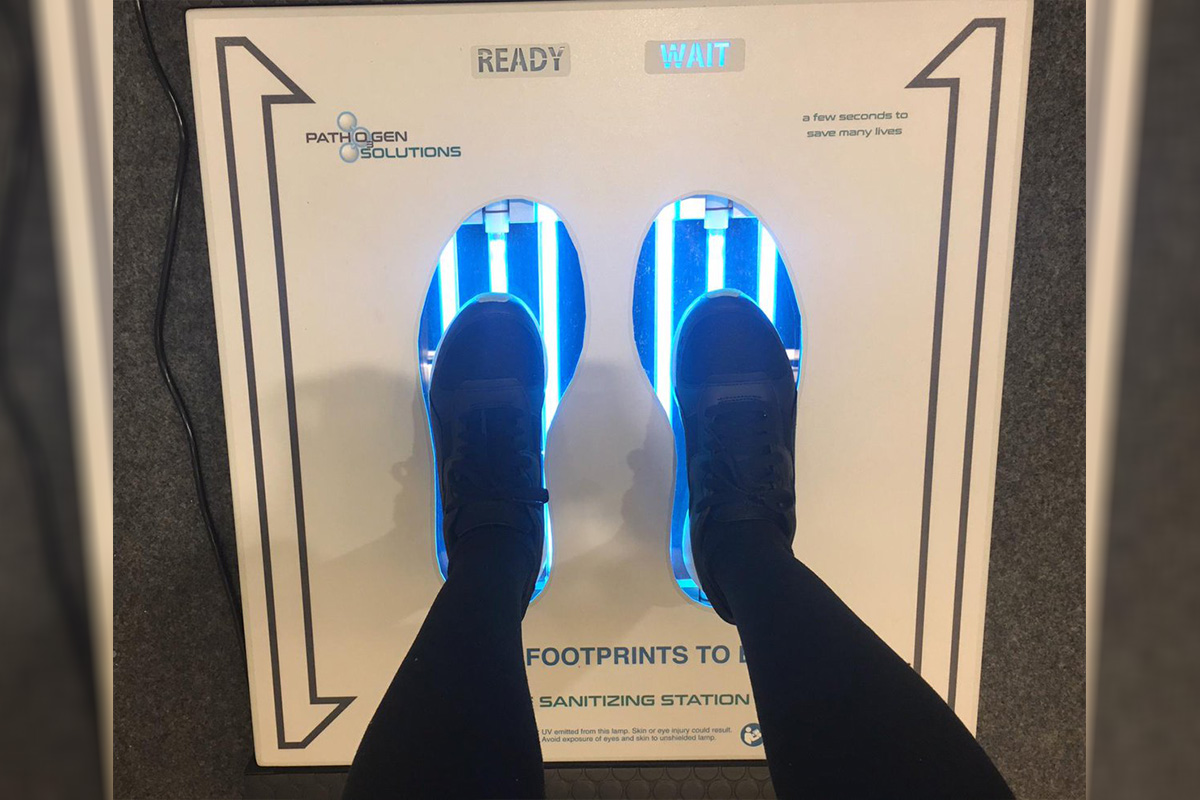In just eight seconds, harmful bacteria, viruses, and fungus clinging to the soles of your shoes – including those associated with COVID-19, MRSA, and other public health scourges – can be stopped dead in their tracks. And one of Corning’s most venerable glass innovations helps make it happen.
Corning and PathO3Gen Solutions began collaborating on the UVZone more than five years ago, with a special interest in mitigating the spread of MRSA, C. diff, E. coli, and similar pathogens. Early reviews were positive.
Since the onset of the COVID-19 pandemic in 2020, the technology has taken on new urgency.
A person entering a sensitive environment simply steps onto the UVZone shoe sanitizing station, a small, portable platform developed by Florida-based PathO3Gen Solutions. The unit activates a controlled release of short-wave ultraviolet light (known as UVC) through a window of Corning® HPFS® Fused Silica (High Purity Fused Silica).
The intense light causes the formation of ozone around the shoe, which breaks the microorganisms’ outer shell so the UVC can destroy them. According to independent studies, the process eliminates up to 99.999% of pathogenic microorganisms on the person’s shoes, preventing further spread. Independent studies also show the multi-patented Ozone+UVC technology is on average 110 times more effective than UVC light alone.
“We’re pleased to utilize Corning’s best-in-class material as we bring our breakthrough UVZone multi-patented Ozone + UVC technology to the world. Utilizing Corning’s HPFS allows us to reduce the spread of pathogenic microorganisms, including Human coronavirus, and change the way the world approaches disinfection and safety protocols.” —Scott Beal, COO, PathO3Gen Solutions
The U.S. Centers for Disease Control has recommended that people in COVID-concentrated areas disinfect their shoes. Hospitals, convalescent centers, food processing plants, and other high-foot-traffic facilities in the U.S. and Europe are adding UVZone technology to their COVID-19 safety protocols, along with mask-wearing and social distancing. Lab tests conducted by CREM Co Laboratories, Ontario show that zero coronavirus residue remains on shoes after stepping on the device for 8 seconds.
Corning HPFS can transmit the intense UVC rays with virtually no attenuation, essential to the effectiveness of the footpad. Corning can also efficiently manufacture HPFS windows in large sizes, which is another reason this material was chosen for this application, as a window large enough to cover shoe soles was needed.
Made in Canton, N.Y.
Corning developed fused silica – and the process used to make it, chemical vapor deposition – in the mid-1930s. Dr. Frank Hyde determined that depositing thin layers of silica created compounds of extraordinary purity. The optical quality mattered in applications where microscopic contaminants might cause unwanted bends or deflections of light.
Chemical vapor deposition became essential to Corning’s development of telescope mirrors, spacecraft windows, and optical fiber. It also established the heartbeat of the company’s HPFS manufacturing efforts in Canton, New York, where astronauts have dropped by to salute employees for their role in U.S. space exploration.
“Canton-made HPFS is better suited than mainstream synthetic quartz products based on the combination of high optical transmission and large format formed parts. It meets both optical and mechanical requirements of PathO3Gen Solutions’ innovation,” said Bob Quinn, director of marketing and intelligence for Corning Advanced Optics. “It’s always nice when the products we sell result in a net benefit for society,” he said. “We have lots of examples of that. It feels good that this application is consistent with our Values, too. Obviously, COVID is the biggest concern right now, but there are lots of pathogens in lots of environments,” he added. “We see this technology as something that’ll contribute to people’s well-being for a long time to come.”



Get involved!
Comments